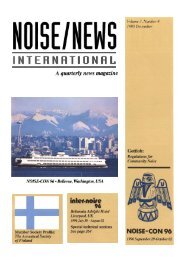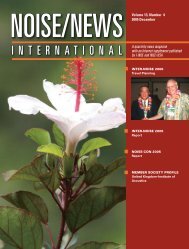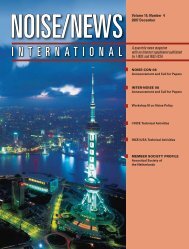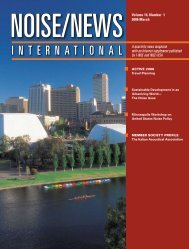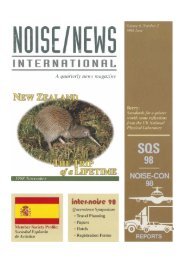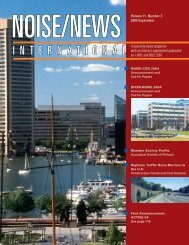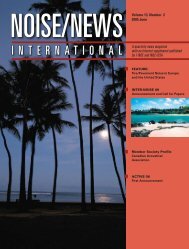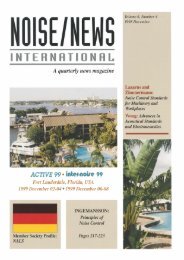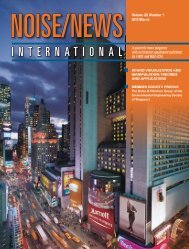Volume 14, Number 4, December, 2006 - Noise News International
Volume 14, Number 4, December, 2006 - Noise News International
Volume 14, Number 4, December, 2006 - Noise News International
Create successful ePaper yourself
Turn your PDF publications into a flip-book with our unique Google optimized e-Paper software.
Chair’s Opening<br />
Remarks—The<br />
Challenge of a<br />
Global <strong>Noise</strong> Policy<br />
What is a Global <strong>Noise</strong> Policy? It is<br />
a high-level overall plan that includes<br />
the general goals and strategy of an<br />
international governmental body or agency<br />
for the control of occupational, community,<br />
and product noise as well as specific<br />
references to relevant codes.<br />
Do we have any effective global noise<br />
policies today? We have at least one that<br />
has been established by the <strong>International</strong><br />
Civil Aviation Organization. ICAO is an<br />
agency of the United Nations linked to the<br />
U.N. Economic and Social Council. ICAO<br />
is concerned primarily with the community<br />
noise affecting those people who live in<br />
the vicinity of airports. ICAO resolutions<br />
set upper limits on the noise generated by<br />
aircraft landing and take-off.<br />
There are other global policies on single<br />
topics like noise control. In May 2003,<br />
the member countries of the World Health<br />
Organization adopted a historic tobacco<br />
control treaty, the Framework Convention<br />
on Tobacco Control (FCTC). This<br />
United Nations treaty took ten years from<br />
conception to realization. Would a similar<br />
treaty, a Framework Convention on <strong>Noise</strong><br />
Control (FCNC) be achievable, and if so<br />
how? A framework convention alliance<br />
on noise control needs to be established.<br />
This would be a global network of NGOs<br />
(non-governmental organizations) who<br />
would come together to consolidate ideas<br />
on actions necessary to initiate a campaign<br />
for a framework convention. The alliance<br />
would then work through the member<br />
states of the U.N. to convene an FCNC.<br />
In many respects, this workshop and its<br />
predecessors are steps on the road to a<br />
global noise policy.<br />
There are signposts along the road to a<br />
global noise policy. One of them is the<br />
<strong>International</strong> INCE report prepared by<br />
its Technical Study Group 5. The report<br />
was published as a draft in a special issue<br />
of <strong>Noise</strong> Control Engineering Journal<br />
in 2004. The final version of the report<br />
appeared in a second special issue of the<br />
same journal in the fall of <strong>2006</strong>. The report<br />
prescribes what is necessary for a global<br />
noise policy to be effective.<br />
Another signpost is the follow-on work<br />
now being initiated by I-INCE’s Technical<br />
Study Group 7 on “Harmonization and<br />
Implementation of Global <strong>Noise</strong> Policies.”<br />
The mission of TSG 7 will be to expand<br />
the TSG 5 final report so that all aspects<br />
of noise (occupational, community, and<br />
product noise) are covered in depth.<br />
The focus here is on occupational and<br />
product noise. What is the link between<br />
the two? Occupational noise is produced<br />
by machinery and equipment—products.<br />
Low-noise products are the first line of<br />
defense against occupational noise. The<br />
link is then the product. Quoting from the<br />
scope of TSG 5:<br />
“All vehicles, devices, machinery, and<br />
equipment that emit audible sound are<br />
manufactured products; most of these<br />
products are involved in international trade.<br />
• “<strong>Noise</strong> emissions of such products are<br />
appropriately the subject of international<br />
agreements and regulations.<br />
• “<strong>Noise</strong> immissions resulting from the<br />
operation of these products are growing in<br />
severity as vehicular traffic volumes and<br />
the pace of industrialization continues to<br />
increase in many parts of the world.”<br />
Up to now, attempts have been made<br />
worldwide to control the noise levels at the<br />
workplace (and in the community) with<br />
immission regulations. This is, in effect,<br />
working backwards from the immission<br />
regulation (of the sound at the receiver’s<br />
ear) to the noise source emission. This<br />
is the key problem. Attempts at working<br />
backwards at the regulatory level have not<br />
often been effective. Many will agree that<br />
the world is getting noisier, not quieter! If<br />
immission regulations were working, that<br />
would not be the case.<br />
The logical approach to this dilemma is<br />
to reduce product noise emissions to the<br />
minimum possible. Note the choice of<br />
the word possible, rather than feasible. It<br />
will take time to implement this forward<br />
approach as it will require that the best<br />
technology be implemented in every<br />
manufactured product. This is the goal of<br />
machinery acoustics that is the extremely<br />
important topic of the next presenter on this<br />
occupational and product noise policy panel.<br />
Panel Presentation<br />
Summaries<br />
The goal of machinery<br />
acoustics – quiet products<br />
without price increases<br />
Gerhard Hübner, ITSM, Stuttgart<br />
University, Germany<br />
All technical developments in our<br />
society must be considered from both<br />
a public interest standpoint and from a<br />
cost standpoint. Let me start with some<br />
remarks dealing with relevant noise policy<br />
to encourage industry to develop lownoise<br />
products. Interest will be focused<br />
on primary noise control, that is, noise<br />
reduction of the principal sources by<br />
effective design of the noise generating<br />
mechanisms. (Primary noise control<br />
by being integral to the design process<br />
becomes inherent in the ultimate design<br />
of the product.) Secondary noise control<br />
measures such as the use of mufflers,<br />
absorbing materials, and/or enclosures<br />
are also effective; but these usually add to<br />
the cost of the product. (An example of<br />
primary noise control is the high-bypassratio<br />
jet aircraft engine and of secondary<br />
noise control is the muffler installed on a<br />
highway vehicle.)<br />
To encourage greater public interest in<br />
quiet products, it may be useful to identify<br />
the following groups:<br />
<strong>2006</strong> <strong>December</strong> www.inceusa.org • www.noisenewsinternational.net • www.i-ince.org<br />
<strong>14</strong>5



